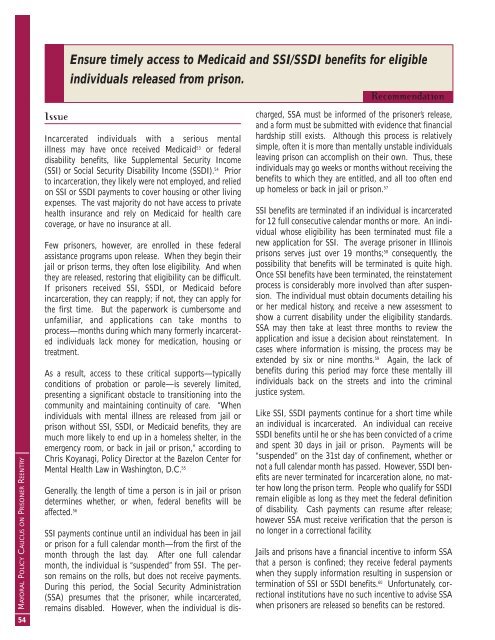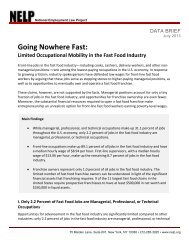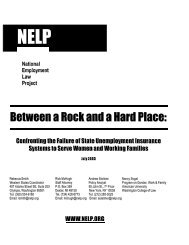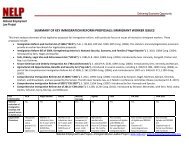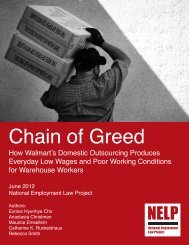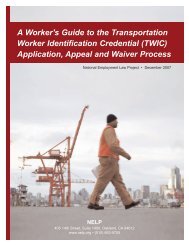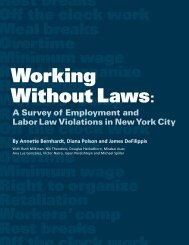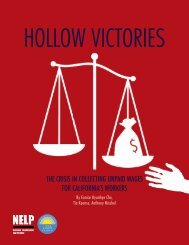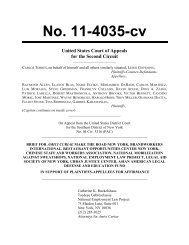Rebuilding Lives. Strengthening Communities.
Rebuilding Lives. Strengthening Communities.
Rebuilding Lives. Strengthening Communities.
You also want an ePaper? Increase the reach of your titles
YUMPU automatically turns print PDFs into web optimized ePapers that Google loves.
MAYORAL POLICY CAUCUS ON PRISONER REENTRY<br />
54<br />
Issue<br />
Ensure timely access to Medicaid and SSI/SSDI benefits for eligible<br />
individuals released from prison.<br />
Recommendation<br />
Incarcerated individuals with a serious mental<br />
illness may have once received Medicaid 53 or federal<br />
disability benefits, like Supplemental Security Income<br />
(SSI) or Social Security Disability Income (SSDI). 54 Prior<br />
to incarceration, they likely were not employed, and relied<br />
on SSI or SSDI payments to cover housing or other living<br />
expenses. The vast majority do not have access to private<br />
health insurance and rely on Medicaid for health care<br />
coverage, or have no insurance at all.<br />
Few prisoners, however, are enrolled in these federal<br />
assistance programs upon release. When they begin their<br />
jail or prison terms, they often lose eligibility. And when<br />
they are released, restoring that eligibility can be difficult.<br />
If prisoners received SSI, SSDI, or Medicaid before<br />
incarceration, they can reapply; if not, they can apply for<br />
the first time. But the paperwork is cumbersome and<br />
unfamiliar, and applications can take months to<br />
process—months during which many formerly incarcerated<br />
individuals lack money for medication, housing or<br />
treatment.<br />
As a result, access to these critical supports—typically<br />
conditions of probation or parole—is severely limited,<br />
presenting a significant obstacle to transitioning into the<br />
community and maintaining continuity of care. “When<br />
individuals with mental illness are released from jail or<br />
prison without SSI, SSDI, or Medicaid benefits, they are<br />
much more likely to end up in a homeless shelter, in the<br />
emergency room, or back in jail or prison,” according to<br />
Chris Koyanagi, Policy Director at the Bazelon Center for<br />
Mental Health Law in Washington, D.C. 55<br />
Generally, the length of time a person is in jail or prison<br />
determines whether, or when, federal benefits will be<br />
affected. 56<br />
SSI payments continue until an individual has been in jail<br />
or prison for a full calendar month—from the first of the<br />
month through the last day. After one full calendar<br />
month, the individual is “suspended” from SSI. The person<br />
remains on the rolls, but does not receive payments.<br />
During this period, the Social Security Administration<br />
(SSA) presumes that the prisoner, while incarcerated,<br />
remains disabled. However, when the individual is discharged,<br />
SSA must be informed of the prisoner’s release,<br />
and a form must be submitted with evidence that financial<br />
hardship still exists. Although this process is relatively<br />
simple, often it is more than mentally unstable individuals<br />
leaving prison can accomplish on their own. Thus, these<br />
individuals may go weeks or months without receiving the<br />
benefits to which they are entitled, and all too often end<br />
up homeless or back in jail or prison. 57<br />
SSI benefits are terminated if an individual is incarcerated<br />
for 12 full consecutive calendar months or more. An individual<br />
whose eligibility has been terminated must file a<br />
new application for SSI. The average prisoner in Illinois<br />
prisons serves just over 19 months; 58 consequently, the<br />
possibility that benefits will be terminated is quite high.<br />
Once SSI benefits have been terminated, the reinstatement<br />
process is considerably more involved than after suspension.<br />
The individual must obtain documents detailing his<br />
or her medical history, and receive a new assessment to<br />
show a current disability under the eligibility standards.<br />
SSA may then take at least three months to review the<br />
application and issue a decision about reinstatement. In<br />
cases where information is missing, the process may be<br />
extended by six or nine months. 59 Again, the lack of<br />
benefits during this period may force these mentally ill<br />
individuals back on the streets and into the criminal<br />
justice system.<br />
Like SSI, SSDI payments continue for a short time while<br />
an individual is incarcerated. An individual can receive<br />
SSDI benefits until he or she has been convicted of a crime<br />
and spent 30 days in jail or prison. Payments will be<br />
“suspended” on the 31st day of confinement, whether or<br />
not a full calendar month has passed. However, SSDI benefits<br />
are never terminated for incarceration alone, no matter<br />
how long the prison term. People who qualify for SSDI<br />
remain eligible as long as they meet the federal definition<br />
of disability. Cash payments can resume after release;<br />
however SSA must receive verification that the person is<br />
no longer in a correctional facility.<br />
Jails and prisons have a financial incentive to inform SSA<br />
that a person is confined; they receive federal payments<br />
when they supply information resulting in suspension or<br />
termination of SSI or SSDI benefits. 60 Unfortunately, correctional<br />
institutions have no such incentive to advise SSA<br />
when prisoners are released so benefits can be restored.


